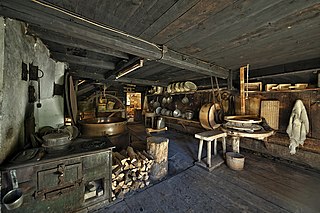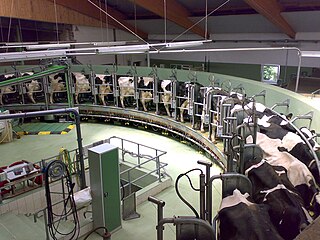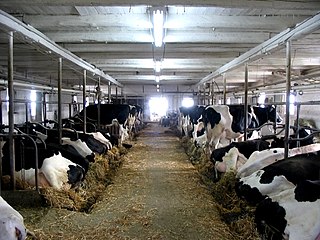History
Milk quotas were first introduced in the United Kingdom on 2 April 1984 under the Dairy Produce Quotas Regulations 1984, [1] which reflected the then European Economic Community (now the European Union's) Common Agricultural Policy. [Notes 1] Originally, they were to run until 1989, but they were extended several times, and were not renewed for the period following 31 March 2015. [5] [3] [4]
Each member of the European Economic Community was allowed to produce dairy products up to a cap, which was based on each state's 1981 production, plus 1%. [6] The cap was designated the "reference quantity". A levy to the EEC was due on production in excess of the reference quantity. This levy was then to be recovered from the farmers or dairies involved. Until 2002, recovery of the levy was down to the Intervention Board for Agricultural Produce. It was then recovered by the Rural Payments Agency on behalf of the UK Department for Environment, Food and Rural Affairs (DEFRA). [7]
The Dairy Produce Quotas Regulations 1994, [8] which came into effect from 1 April 1994, substantially revised the old structure. Until 31 March 1994, the MAFF ("Ministry of Agriculture, Fisheries and Food", a British government department that has since been replaced by DEFRA) was responsible for milk quotas, together with the Secretaries of State for Scotland and Wales and the Department of Agriculture for Northern Ireland. [9] On the MAFF's behalf, Milk Marketing Boards kept a register of quotas that detailed which farmers or dairies held what quotas. The Milk Marketing Boards were dissolved on 31 October 1994 (in England, Wales and Scotland) and 28 February 1995 (in Northern Ireland).
The final regulations governing milk quotas were the Dairy Produce Quotas Regulations 2005, [10] the Dairy Produce Quotas (Scotland) Regulations 2005 [11] and the Dairy Produce (Quotas) (Wales) Regulations 2005, [12] as amended.
Acquisition and transfer
The EEC did not originally mean for milk quotas to attract a value. Contrary to their intent, milk quotas became a valuable asset, although prices fell towards the end of their life. Milk quotas could be purchased outright or leased. [3] [14]
Although the quotas were normally attached to land, and transferred with it provided the transfer is not a tenancy of less than ten months, they could be traded separately. [Notes 2] The legality of such a transfer was questioned by the Courts, particularly in Carson v Cornwall County Council [1993] 1 EGLR 21, [1993] 03 EG 119, but since 1994 was accepted, at least in a limited way, in for example Harris v Barclays Bank Plc [1997] 2 EGLR 15, [1997] 45 EG 145, CA. [15]
Milk quotas could also be transferred without payment if the tenant of a holding under the Agricultural Holdings Act 1986 ceased to use that land for dairy farming purposes for five years and transferred that quota to other land that he held for dairy farming purposes if there was no quota protection clause in the tenancy. In the absence of such a clause, a tenant under the Agricultural Holdings Act 1986 or the Agricultural Tenancies Act 1995 also seemed, in principle, to be free to sell the quota attaching to the land he rented on the open market. That has been called quota "massage" or even quota "theft", but Williams (2011) called the latter term "inelegant and inappropriate" since it was apparently lawful. [16]
Disputes about milk quota were generally referred to arbitration.

A dairy is a place where milk is stored and where butter, cheese and other dairy products are made, or a place where those products are sold. It may be a room, a building or a larger establishment. In the United States, the word may also describe a dairy farm or the part of a mixed farm dedicated to milk for human consumption, whether from cows, buffaloes, goats, sheep, horses or camels.

The Common Agricultural Policy (CAP) is the agricultural policy of the European Union. It implements a system of agricultural subsidies and other programmes. It was introduced in 1962 and has since then undergone several changes to reduce the EEC budget cost and consider rural development in its aims. It has however, been criticised on the grounds of its cost, its environmental, and humanitarian effects.

The Ministry of Agriculture, Fisheries and Food (MAFF) was a United Kingdom government department created by the Board of Agriculture Act 1889 and at that time called the Board of Agriculture, and then from 1903 the Board of Agriculture and Fisheries, and from 1919 the Ministry of Agriculture and Fisheries. It attained its final name in 1955 with the addition of responsibilities for the British food industry to the existing responsibilities for agriculture and the fishing industry, a name that lasted until the Ministry was dissolved in 2002, at which point its responsibilities had been merged into the Department for Environment, Food and Rural Affairs (Defra).

Dairy farming is a class of agriculture for the long-term production of milk, which is processed for the eventual sale of a dairy product. Dairy farming has a history that goes back to the early Neolithic era, around the seventh millennium BC, in many regions of Europe and Africa. Before the 20th century, milking was done by hand on small farms. Beginning in the early 20th century, milking was done in large scale dairy farms with innovations including rotary parlors, the milking pipeline, and automatic milking systems that were commercially developed in the early 1990s.

Raw milk or unpasteurized milk is milk that has not been pasteurized, a process of heating liquid foods to kill pathogens for safe consumption and extending the shelf life.
Nemo dat quod non habet, literally meaning "no one can give what they do not have", is a legal rule, sometimes called the nemo dat rule, that states that the purchase of a possession from someone who has no ownership right to it also denies the purchaser any ownership title. It is equivalent to the civil (continental) Nemo plus iuris ad alium transferre potest quam ipse habet rule, which means "one cannot transfer to another more rights than they have". The rule usually stays valid even if the purchaser does not know that the seller has no right to claim ownership of the object of the transaction ; however, in many cases, more than one innocent party is involved, making judgment difficult for courts and leading to numerous exceptions to the general rule that aim to give a degree of protection to bona fide purchasers and original owners. The possession of the good of title will be with the original owner.

Crofting is a form of land tenure and small-scale food production particular to the Scottish Highlands, the islands of Scotland, and formerly on the Isle of Man. Within the 19th-century townships, individual crofts were established on the better land, and a large area of poorer-quality hill ground was shared by all the crofters of the township for grazing of their livestock. In the 21st century, crofting is found predominantly in the rural Western and Northern Isles and in the coastal fringes of the western and northern Scottish mainland.

The Rural Payments Agency (RPA) is an executive agency of the UK Department for Environment, Food and Rural Affairs (Defra). Prior to Brexit, the RPA delivered the European Union (EU) Common Agricultural Policy (CAP) payments to farmers and traders in England, paying out over £2 billion in subsidies each year. The Agency managing more than 40 schemes, the largest of which the Basic Payment Scheme (BPS) paying more than £1.5 billion to around 105,000 claimants a year.
The Irish Land Commission was created by the British crown in 1843 to 'inquire into the occupation of the land in Ireland. The office of the commission was in Dublin Castle, and the records were, on its conclusion, deposited in the records tower there, from whence they were transferred in 1898 to the Public Record Office'. It took on the role of a rent fixing commission in 1881 via the Land Law (Ireland) Act 1881, also known as the second Irish Land Act. For a century it was the body responsible for re-distributing farmland in most of Ireland. It was formally abolished in 1999.

The Central Science Laboratory (CSL) was an executive agency of the UK government branch, the Department for Environment, Food and Rural Affairs (DEFRA). It is now part of the Food and Environment Research Agency, which is in turn part of DEFRA.

Agriculture in the United Kingdom uses 69% of the country's land area, employs 1% of its workforce and contributes 0.5% of its gross value added. The UK currently produces about 60% of its domestic food consumption.

The share of agriculture in Austria in the Austrian economy declined steadily after World War II, agriculture continues to represent an important element of the economy because of its social and political significance. The Chamber of Agriculture remains on an equal level with the chambers of commerce and labor, although its members produce only a fraction of the GDP that industrial and commercial workers produce.

Dairy farming is one of the largest agricultural sectors in Canada. Dairy has a significant presence in all of the provinces and is one of the top two agricultural commodities in seven out of ten provinces.

Ornua, from the Irish "Ór Nua" meaning "new gold", is an Irish agricultural cooperative, which markets and sells dairy products on behalf of its members: Irish dairy processors and Irish dairy farmers. The co-operative is Ireland’s largest exporter of Irish dairy products and owns the Kerrygold butter and cheese brand as well as Kerrygold Irish Cream Liqueur. In addition to the Kerrygold brand, its brand portfolio includes Pilgrims Choice, Dubliner, Shannongold, and BEO milk powder.

The Agricultural Holdings Act 1995 is an Act of the Parliament of the United Kingdom which applies to England and Wales. It is in force. The Act reformed and substantially deregulated the law relating to agricultural tenancies, and has had the dual effects of increasing the amount of land available to rent in the agricultural sector, and increasing the average rent per acre charged.

Canada's supply management, abbreviated SM, is a national agricultural policy framework used across the country, which controls the supply of dairy, poultry and eggs through production and import controls and pricing mechanisms. The supply management system was authorized by the 1972 Farm Products Agencies Act, which established the two national agencies that oversee the system. The Agriculture and Agri-Food Canada federal department is responsible for both the Canadian Dairy Commission and its analogue for eggs, chicken and turkey products, the Farm Products Council of Canada. Five national supply management organizations, the SM-5 Organizations — Egg Farmers of Canada (EFC), Turkey Farmers of Canada (TFC), Chicken Farmers of Canada (CFC), the Canadian Hatching Egg Producers (CHEP) and the Ottawa-based Canadian Dairy Commission (CDC), a Crown corporation — in collaboration with provincial and national governing agencies, organizations and committees, administer the supply management system.
The Common Market Organization for Sugar regulates the sugar market in the European Union. For a long time, it was also known as the EU sugar quota system, after its most notable aspect. The sugar production quotas were in place from 1968 to 2017. Before ending the system the quota system, a thorough restructuring of the sugar production sector took place between 2006 and 2010. What now remains of the Common Market Organization is a much looser regulation.













